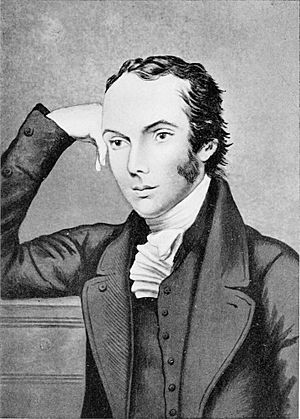Thomas Pringle facts for kids
Thomas Pringle (born January 5, 1789 – died December 5, 1834) was a Scottish writer, poet, and a strong supporter of ending slavery. He is often called the "father of South African poetry." He was the first English-speaking poet and writer to successfully describe South Africa's beautiful landscapes, its native people, and how life was there.
Contents
Thomas Pringle's Early Life
Thomas Pringle was born in a place called Douglas (now Blakelaw), near Kelso in Scotland. He went to Kelso Grammar School and later studied at Edinburgh University. He was very good at writing. Because of an injury he had when he was a baby, he couldn't follow his father into farming. Instead, he worked as a clerk and kept writing. Soon, he became an editor for newspapers and magazines, like Edinburgh Monthly Magazine.
Moving to South Africa
In 1816, a poem Pringle wrote about the countryside caught the eye of a famous writer, Sir Walter Scott. They became friends. Thomas Pringle was having a hard time making a living. With Scott's help, he got free travel and an offer of land from the British Government to move to South Africa. He moved there in 1820.
This move was part of a plan to settle English-speaking people on the eastern border of the Cape. The idea was to create a barrier against local African groups. Thomas Pringle led a group whose farms were given in the Baviaans River Valley. This was many miles away from most of the other 5,000 settlers.
Because of his old injury, Thomas Pringle chose to work with words in Cape Town instead of farming. He opened a school with another Scotsman, John Fairbairn. He also ran two newspapers, the South African Journal and the South African Commercial Advertiser. However, these papers were shut down because they openly criticized the government in charge of the colony. His school was also closed.
Fighting Against Slavery
Without a way to earn money and with debts, Thomas Pringle returned to Britain and settled in London. He had written an article against slavery while in South Africa. This article was published and got the attention of important people like Buxton and Zachary Macaulay. This led to him becoming the Secretary of the Anti-Slavery Society.
He started working for the Anti-Slavery Society in March 1827 and continued for seven years. He helped Mary Prince, a former slave, to write her life story. Her book described her experiences as a slave in the West Indies. This book caused a big stir and was printed many times. He also published his own books of poems, like African Sketches.
As Secretary, he helped the Anti-Slavery Society achieve its goal. In 1834, the British Parliament passed a law to end slavery in all British lands. This was what Pringle's Society had worked for. Pringle signed the Society's notice to celebrate August 1, 1834, as a day of thanks for the law passing.
However, the law didn't fully take effect until August 1838. Thomas Pringle sadly passed away from tuberculosis in December 1834, at the age of 45. He did not live to see the complete end of slavery.
Remembering Thomas Pringle
After he died, a book about his life was published. It was called Biographical Sketch of the Late Thomas Pringle (1835). It was sold together with Pringle's own book, Narrative of a Residence in South Africa (1834).
Thomas Pringle was first buried in Bunhill Fields in London. In 1970, his remains were brought back to South Africa. They were reburied near the farm his family owned in the Baviaans Valley.


